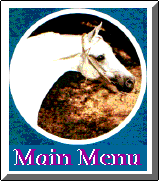*NABORR SEEMS TO HAVE captivated the international
Arabian horse community. Very quietly, very regally, and
very definitively. His extraordinary beauty, his merit as a
sire, his nobility and bearing, and his ability to
emotionally involve the persons in his life made him nearly
irresistible to anyone touched in any way by Arabian horses.
|
We first heard about *Naborr in 1958 when Patricia
Lindsay of Stockings Farm in England wrote of her visit to
Poland that year. She spent time at Michalow State Stud and
described *Naborr there: "Particularly interesting was the
pure white Nabor, probably the best of the imports from
Russia. This horse is a grandson of Naseem by direct male
line and was bought to reintroduce the blood of Skowronek to
Poland. He already has some very good progeny, stamping them
all with lovely heads and a charming gaiety of carriage." A
grandson of Naseem? Imports to Poland from Russia? All news,
and highly intriguing, to Americans who wondered how Arabian
horse breeding in Poland and Russia had survived World War
II.
*Naborr's foaling at Tersk Stud in Russia, only five
years after the end of World War II in Europe, was part of
the aftermath of the capture and removal of horses as war
booty. His granddam Obra (Hardy x Ikwa) was foaled at
Janow-Podlaski Stud in Poland in 1933 and went to a private
breeder, Stanislaw Magielski at Jablonka Stud in the Konin
District. There she was bred to Posejdon (a son of Ibrahim,
the sire of Skowronek) and foaled a grey filly in 1939 for
her first foal. The filly was named Lagodna, which means
"gentle" in Polish. Lagodna and Obra disappeared in 1939;
however, they were not among the 100+ choice Arabians
scooped up by the Russians as they swept through Poland.
Sometime between 1939 and 1945 (probably in 1943), Lagodna
was taken to the German Trakhener State Stud where she was
known as "Odilgard"or "Lagodna Odilgard." She apparently was
bred to Trakhener stallions there, although we know the
Polish-bred Arabian stallion Lowelas (Koheilan I x
Elegantka) was taken to the same stud.
In early 1946, the Russians took Lagodna, along with
five other Polish-bred mares, to Tersk Stud. Lagodna had her
1946 Trakhener foal at her side and she was again in foal to
a Trakhener stallion. Both foals are listed in Volume I of
the Russian Arabian Stud Book. In 1944, the Soviet
government granted to Tersk the exclusive right to breed
purebred Arabians; all partbreds at Tersk were moved to
Stavropol Stud Farm, so Lagodna's foals may have been sent
there.
At Tersk, Lagodna produced four more foals (three colts
and one filly), and then was sold. In 1949 she was bred to
the stallion Negatiw, a son of Naseem (by the Polish-bred
stallion Skowronek). In 1936, when he was 14, Naseem was
included in the 25 Crabbet-bred Arabians Lady Wentworth sold
to representatives of the Russian government. Of the six
stallions in the Crabbet purchase, Naseem is the only one
whose line was perpetuated at Tersk. From 1936 to 1951, he
sired 87 purebreds and 50 partbred Arabians. Of his 45
purebred sons, six were entered in the stud book, and 20 of
his 42 daughters were entered. Negatiw, foaled in 1945, was
out of Taraszcza (Enwer-Bey x Gazella II), a Polish-bred
mare confiscated by the Russians at Janow-Podlaski in 1939.
Negatiw's first foals were born in 1949--a colt and a
filly--and Lagodna was one of 12 mares selected to be bred
to him for 1950. She foaled a grey colt on April 13, 1950,
and he was named "Nabor."
|
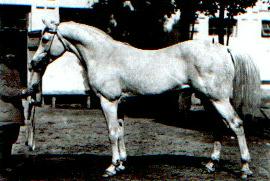
Naseem
|
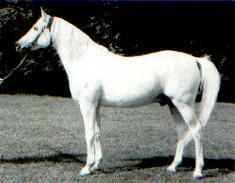
Negatiw
|
*Naborr (Nabor) was entered in Volume I of the
Russian Arabian Stud Book with the notation that he
was considered "Grade I." His measurements are listed at 149
centimeters (height at the withers), 147 centimeters (from
point of shoulder to point of buttock), 172 centimeters
(girth), and 18 centimeters (bone). When *Naborr was two he
raced at Piatygorsk, winning two of eight races. His times
are recorded as 1,500 meters in 1:54, 1,600 meters in 1:55,
and 1,800 meters in 2:10.
|
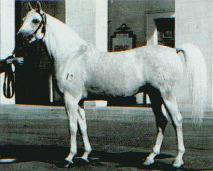
*Naborr
|
In 1954, the Tersk Arabians won their first awards at
the All-Union Agricultural Fair in Moscow, where they
competed against all Russian breeds of horses. *Naborr, at
age four, was awarded the "Certificate of the First Class"
(the equivalent of our National Reserve Championship), and
his sire Negatiw was awarded the championship. That same
year, *Naborr was first used at stud at Tersk; four foals
were born in 1955 and five in 1956, for a total of six colts
and three fillies. One colt King, out of Kompositsia (Korej
x Mulatka), was registered in the stud book; none of the
fillies were registered. King, in turn, sired one filly who
was not registered as a broodmare, so the *Naborr line was
not continued at Tersk.
|
As the Poles rebuilt their shattered and scattered
Arabian breeding program after World War II, they realized
they had no stallions of the Ibrahim sire line. The
desert-bred Ibrahim had been imported to Poland by Count
Josef Potocki for Antoniny Stud in 1907, but no direct sire
line descendants were available to the program. By that
time, Ibrahim's son Skowronek was acclaimed as "the horse of
the century," "the great progenitor," and as one of the most
influential sires of the breed. The Poles knew of his son
Naseem and grandson Negatiw as highly successful sires at
Tersk. In 1955 they obtained *Naborr, a direct sire line
descendant of Ibrahim (and with two more crosses to
Ibrahim), for the Polish State Studs. *Naborr arrived in
Poland in the fall of 1955 and was taken to the Klikowa
Stallion Depot for a short time. The Poles loved him, for
they found in *Naborr a resemblance to the Arabian horses
painted by Juliusz Kossak, considered the best painter of
oriental horses. *Naborr's remarkable Arabian type, dry fine
head, swan-like neck, and milk-white hair (unusual for his
age) all related to the Poles' ideal Arabian.
*Naborr's first year at stud in Poland (1956) was at
Albigowa State Stud in the Lancut District, a site used
until Janow-Podlaski was rebuilt. Seven foals (four fillies
and three colts) were born in 1957. The dams were daughters
of the top Polish stallions Witraz, Wielki Szlem, and
Koheilan I. *Naborr was moved to the recently established
Michalow State Stud (in the Pinczow District) for the 1957
breeding season. There he came into the care of Ignacy
Jaworowski, the Director of Michalow, who became a lifelong
admirer of *Naborr. Mr. Jaworowski rode him and appreciated
his docile character, his dignity, and innate intelligence.
The first year at Michalow, *Naborr bred seven mares, plus
one at Nowy Dwor Stud. The 1957 mares included three sired
by Amurath Sahib (35. Amurath II AUST/PASB x Sahiba PASB).
*Naborr stayed at Michalow through the 1963 breeding season
when his life was again dramatically changed, this time by
Americans.
|
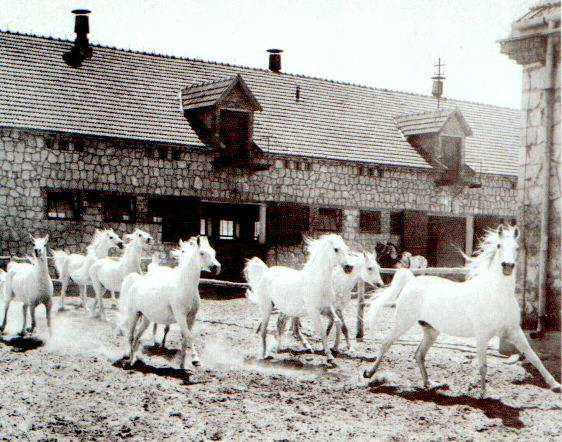
*Naborr's daughters--"the dancers." Gadzalski
photo.
|
IN 1962, Dr. Eugene LaCroix of Lasma Arabians and his
friend Dr. Howard F. Kale of Kale Arabians visited the
Polish studs, some of the first Americans to travel there
post-World War II. The trip was Dr. LaCroix's follow-through
on his "Wow!" impression of the 1960-1961 Polish Arabians
imported via the "mail order" Gladys Brown Edwards-Patricia
Lindsay-Animex connection. Miss Lindsay brought the first
Polish-bred Arabians since Skowronek into England in 1958
following her visit there and maintained good relations with
the Poles. She was also an accomplished linguist, and this
skill served her well. The imports to the United States, the
first since the prizes of war in 1945, suggested Poland as a
source of prime breeding stock, and Dr. LaCroix couldn't
wait to get to the nest. He was not disappointed; he was
overwhelmed. The beauty, elegance, athletic ability, and a
certain exuberance were there in abundance, and he was ready
to import a sampling to the United States. When he arrived
back in Scottsdale, he told wonderful stories of the Polish
Arabians, and he carried photos and movies to back up his
stories. One of the persons who listened to his travel tales
with unusual interest was Mrs. Anne McCormick, a Scottsdale
Arabian breeder.
Mrs. McCormick, a Chicagoan transplanted to Scottsdale,
was an independent thinker, known for her scholarly approach
to livestock breeding. She was a highly successful cattle
breeder and transferred her knowledge of genetics and
breeding theories to Arabian horses. As she lis-tened to Dr.
LaCroix's stories of the beauty and usefulness of the Polish
Arabians, the appeal of importing was there. Dr. LaCroix
showed her a photograph of a *Naborr son and suggested she
might be able to acquire him. Her reaction, after seeing
photos of *Naborr, was, "Well, *Naborr looks better to me.
Why not import the sire?" Dr. LaCroix had toyed with this
idea too, but had been told the Poles would not part with
him. Mrs. McCormick was also known as a formidable and
determined woman. She did not see the fact that *Naborr was
not for sale as a deterrent. She in-sisted on a phone call
("I'm paying the tariff. You call.") to Patricia Lindsay in
England who could contact Animex in Poland. The message to
be relayed to the Poles: Mrs. McCormick wants to buy
*Naborr. What is the price? Miss Lindsay reinforced Dr.
LaCroix's feeling that *Naborr was too valuable to the
Polish breeding program to consider selling him. She was
reminded, "All they can do is say no." In time, the message
came back via Miss Lindsay with a price obviously calculated
to discourage the lady in Scottsdale. Instead, she said,
"I'll take him."
Dr. LaCroix rallied other Scottsdale breeders and
friends to join in the importation effort. After frustrating
delays caused by a dockworkers' strike in New York and
Poland's worst winter in 100 years, 15 Polish Arabians were
loaded on board ship late in January 1963. The cargo was
precious. It included the stallions *Naborr and *Bask, both
to have unending influence on Arabian horse breeding
worldwide, and mares of great merit. The crossing was not
smooth. The ship ran into a wicked storm, made no progress
westward for ten days, and food supplies ran low. Forty-four
days later, on March 9, 1963, the ship docked in New York.
One mare had aborted at sea and died within a few days All
the horses were down in weight and generally battered and
skinned. Except *Naborr. He was calm, unscathed, and had
lost only about 50 pounds, much less than the others. Harold
Daugherty, Mrs. McCormick's ranch manager, and her son Guy
Stillman were in New York to meet *Naborr. Before the ship
docked, they were on a launch in the harbor so they could go
on board for their first look at *Naborr, the only horse in
the lot with a five-figure price tag. Mr. Jaworowski, as one
of Poland's leading horse specialists, accompanied the
horses, and Harold Daugherty was able to visit with him--in
spite of language problems--and learn more about *Naborr.
After time in quarantine, *Naborr was taken to the McCormick
ranch, where Mrs. McCormick immediately acknowledged his
beauty and the wisdom of her purchase and began planning his
contributions to her breeding program.
*Naborr was nearly limited to the McCormick breeding
program. Mrs. McCormick was a woman of wealth and had no
desire or need to make a profit with her Arabian horses, and
she had no interest in the notoriety generated by *Naborr as
the first Tersk-bred Arabian to arrive in the United States.
The curious called, wrote, and stopped by. Many wanted to
book mares, but Mrs. McCormick was concerned only with his
influence on her Arabians. Other than her family members,
only a favored few were approved to bring mares to *Naborr:
Dr. LaCroix, Dr. Howard Kale, Daniel C. Gainey, Emile
Goyette, and Bazy Tankersley.
|
MRS. McCORMICK DIED in 1969 at age 90, and her will
stipulated that her Arabians be sold at public auction. A
small, unpretentious, black and white catalog announced the
liquidation sale at the McCormick Ranch on North Scottsdale
Road in October. Of the 50 lots in the sale, only *Naborr
was pictured. At age 19, the catalog stated, he was in
excellent breeding condition, and a group of underwriters
agreed to insure him for 80% of his purchase price, up to
$100,000. The curiosity level was high, and the rumor mill
produced more speculation each day. Pre-sale, there was talk
of syndicates ready to buy *Naborr and that he might bring
as much as $100,000, talk of celebrities interested in him,
and talk of his going back to Europe.
|
The speed and efficiency of the Arabian horse grapevine
has evoked amazement for years, but Wednesday, October 15,
1969, must have been a record-setter. The news flash of the
heretofore unheard of $150,000 for *Naborr and the name of
the buyer sped from coast to coast, and almost as fast, the
question came back, "Who is this Tom Chauncey who bought
him?" A former Texan, jeweler, rancher (cattle,
thoroughbreds, and quarter horses), respected civic leader
in Phoenix, and owner of radio and television stations; a
man who came under *Naborr's spell with the first look at
the McCormick Ranch in 1963; and a man whose life would be
wrapped around *Naborr from that day on.
|









